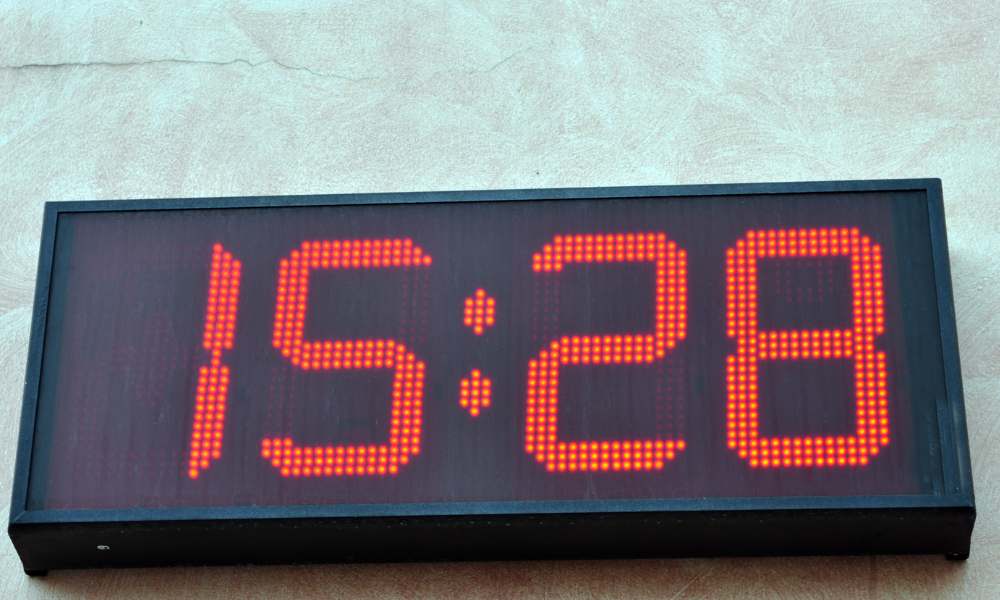Accurate timekeeping is a cornerstone of daily life, essential for managing schedules, coordinating events, and maintaining a sense of order. Whether it’s catching a train, attending a meeting on time, or preparing meals, every aspect of our routine relies on precise time management. However, when a digital clock starts running fast, it can throw our entire schedule into disarray, leading to missed appointments, early or late arrivals, and a general sense of disorganization. This seemingly minor issue can have ripple effects, impacting professional commitments and personal plans alike. In this blog post, we will delve into why digital clocks running ahead of time, exploring the common causes and the potential impacts of this malfunction. Understanding these factors is key to resolving the issue and restoring the reliability of your timekeeping devices, ensuring that your daily activities proceed as planned without any unwelcome surprises.
Understanding the Basics
Digital clocks are marvels of modern timekeeping, fundamentally reliant on precise and sophisticated internal components. At the core of most digital clocks is a quartz crystal, which serves as the timekeeping device. When an electric current is passed through the quartz crystal, it oscillates at a highly stable frequency, typically 32,768 times per second. This consistency allows the clock to measure time with remarkable accuracy. The oscillations are then translated into digital time readouts—hours, minutes, and seconds—through electronic circuitry. This circuitry, including a series of microprocessors and other electronic components, processes the oscillations to display the current time digitally, usually on an LCD or LED screen. The intricate interaction between the quartz crystal and the electronic circuitry ensures that digital clocks not only display the precise current time but also maintain this accuracy consistently over periods of use.
Common Causes of a Fast Clock

Several factors can cause a digital clock to run fast, disrupting its accuracy and reliability. One common reason is misconfiguration of settings. Users may inadvertently set the clock to a faster time zone or adjust the settings improperly, leading to an incorrect time display. Another critical issue lies within the clock’s internal electronics. Faults in the circuit board, such as aging capacitors or resistors that have shifted from their original values, can affect the clock’s timing mechanism, causing it to run fast.
Additionally, environmental factors play a significant role; for instance, extreme temperatures can affect the oscillation rate of the quartz crystal. High temperatures, in particular, can cause the crystal to oscillate faster than normal, speeding up the time displayed by the clock. These diverse causes, from simple user errors to complex electronic malfunctions or environmental impacts, all contribute to the phenomenon of a Digital Clock Running ahead of actual time.
Quartz Crystal Oscillation Issues
In digital clocks, quartz crystals are pivotal for maintaining time due to their ability to oscillate at a consistent frequency when subjected to an electric current. This consistency arises from the piezoelectric property of quartz, which causes it to produce a regular electrical pulse with each vibration when voltage is applied. However, certain factors can disrupt this steady rhythm, causing the crystal to oscillate faster than intended.
Temperature fluctuations are a primary influence; notably, elevated temperatures can increase the oscillation rate, leading the clock to run fast. Similarly, physical stress such as shock or vibration can temporarily alter the structure of the quartz, affecting its oscillatory behavior. These changes impact the crystal’s ability to provide a stable frequency, which is crucial for accurate timekeeping in digital clocks. Thus, any variation in environmental conditions or physical handling that affects the quartz can lead to significant errors in how the clock measures and displays time.
Power Supply Problems

The power supply plays a crucial role to keep a digital clock running, as it directly influences the stability and performance of their internal components, particularly the quartz crystal oscillator. Fluctuations in the power source, such as variations in voltage or intermittent power failures, can disrupt the regular oscillation of the quartz crystal, leading to inaccuracies in timekeeping. For instance, a sudden drop in voltage might cause the clock to reset or alter the frequency of the crystal’s oscillations, thereby speeding up or slowing down the clock.
To maintain a stable power supply and prevent such issues, it is advisable to use a consistent and reliable power source. For battery-operated clocks, regular checks and timely battery replacements are essential to avoid low power conditions that can affect clock speed. For clocks plugged into an electrical outlet, using a surge protector can help mitigate the effects of voltage spikes and provide a more stable power flow. Ensuring these conditions can greatly enhance the reliability and accuracy of digital clocks, keeping them running precisely as expected.
Troubleshooting and Fixing the Issue
When a digital clock runs fast, troubleshooting and fixing the issue can often be accomplished with some basic steps. Initially, check and adjust the settings on your clock. Ensure that the time zone and any configuration settings related to time adjustment are correctly set, as incorrect settings can sometimes cause the clock to display time inaccurately. If settings adjustments do not resolve the issue, visually inspect the clock for any signs of damage or wear, particularly around the battery compartment or power connection points. Look for loose connections, corrosion, or any other visible faults that might affect the clock’s function. If these steps don’t remedy the situation, it’s important to consider the complexity of further repairs.
For simple battery replacements or external power supply issues, a DIY approach might be sufficient. However, for internal problems related to the electronic circuitry or quartz crystal, professional repair is often advisable. Attempting to repair sophisticated internal mechanisms without the proper skills and tools can lead to further damage or may even render the clock inoperable. Therefore, weighing the complexity of the issue against your technical ability is crucial in deciding between a DIY fix and seeking professional assistance.
Preventive Measures and Maintenance

To prevent your digital clock from running fast and ensure its longevity and accuracy, adopting regular maintenance practices and mindful placement are key. Start by placing the clock in an environment with stable temperature conditions, as extreme heat or cold can affect the quartz crystal’s oscillation and lead to inaccuracies. Regularly check and replace batteries if the clock is battery-operated, or ensure that the power adapter and outlet are functioning correctly for electrically powered clocks. Using high-quality, reliable power sources can prevent fluctuations that might otherwise impact the clock’s timing mechanism.
Additionally, it’s beneficial to perform periodic checks of the clock’s settings to ensure they remain correct, especially after power outages or when daylight saving time adjustments occur. Cleaning the clock, particularly around any buttons and battery compartments, can prevent dust accumulation that might interfere with the electronic components. These preventive measures, when combined with careful handling and avoidance of physical shocks, can significantly reduce the likelihood of your clock running fast, maintaining its accuracy and reliability over time.
Final Thought
Several factors can cause a digital clock to run fast, ranging from simple misconfigurations and power supply issues to more complex problems involving the quartz crystal oscillator or environmental factors. Understanding these potential causes is crucial for effectively diagnosing and addressing any discrepancies in timekeeping. As we have explored, maintaining the accuracy of your digital clock involves regular checks and adjustments, proper handling, and the use of reliable power sources. It also requires mindfulness of the environmental conditions in which the clock operates. By taking proactive steps in monitoring and maintaining your digital clocks, you can ensure their optimal performance and dependability.
Remember, a well-maintained digital clock is more than just a device to tell time; it’s a reliable tool that helps organize and structure your daily activities. Therefore, keep a close eye on your timekeeping devices, promptly address any issues, and continue to enjoy the benefits of accurate and reliable time measurement in your daily life.

